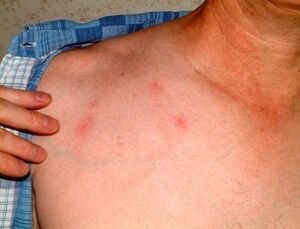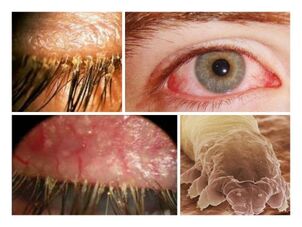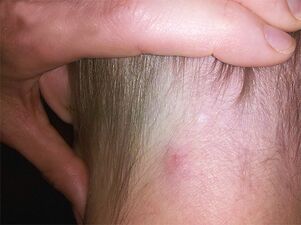
Pictures and videos of symptoms of subcutaneous parasites in humans are not a pleasant sight. Unlike intestinal worms, whose existence one may not even know, epithelial infection is easy to see. In this case, a person experiences constant discomfort due to the symptoms that accompany the injury. This helps to initiate a diagnosis and initiate treatment as soon as possible. This photograph of the human subcutaneous parasite evokes almost disgusting emotions, but the symptoms of infection are much more unpleasant. The photo does not convey a person's feelings when realizing that someone is crawling along his or her body. But an infection of the epithelium is not only uncomfortable, but also a significant danger to the health of the entire body. The toxin secreted by the parasite's body can affect all organ systems, the helminth itself loves to spread throughout the human body. So the manifestation of dermatological diseases can be a sign of danger to the patient's life due to the presence of helminths in the brain, visual organs or heart.
What parasites live in the skin?
Dermatological problems can cause many types of infections. If, during intestinal infection, the presence of worms is most often diagnosed, then insects and protozoa can also be found under the skin. Mosquitoes, ticks, and other blood-sucking parasites often eat and separate from humans unnoticed, but there are species that continue to live and multiply in the body.
Each of these infections has its own ways of entering the human body. The symptoms and effects of the infection also vary. Accordingly, the treatment of the disease will take place in many different ways. But to distinguish one parasitic infection from another and identify a person who lives in the human body, it is necessary to undergo a long diagnostic process. The doctor, who knows the characteristics and habitats of the various parasites, will recommend the most possible option even before the start of the test, focusing solely on symptoms and travel maps of the world. the patient's gender.
Microorganisms
The most common of these is leishmaniasis. It is caused by the simplest parasites, which have given the name to this pathology. 9/10 infections occur in only a few countries:

- Syria;
- Iran;
- Saudi Arabia;
- Afghanistan;
- Peru;
- Brazil.
The disease is transmitted by mosquitoes and some flies. Pathogenic microorganisms do not exist in temperate climates, so you can get leishmaniasis only after resting in hot tropical countries.
When infected, the infection will form sores on the spot where the insect bites. Over time, it heals and leaves a scar that is difficult to heal. With many foci, leishmaniasis can look like leprosy. The danger of this disease is that it passes from the skin into the lymphatic system and can affect internal organs, gradually destroying them. At the same time, the parasite lives inside the cell, so the immune organs have little use against protozoa. But after a fight with leishmaniasis, an immunity was formed.
Insects among subcutaneous parasites
Such infestation diseases are called insects. There are several types of these subcutaneous parasites in humans:
- Sarcopsillosis (whip disease).Called by tropical sand fleas. Simply walking barefoot on the beach or lying in the sun for insects to crawl on is enough. It is not noticeably hidden under the outer layer of the epithelium until blood sickness. Then the flea "fattens" and begins to press on surrounding tissues, causing discomfort. When it dies, it is excreted from the body with the dead skin peeling off. If this does not occur, compression and tissue abscess may occur.
- Fungal skin diseases.South American flies bite the larvae under human skin. When fully developed, they tear the tissue and leave the body, leaving an open wound. In cases where the eyelids are damaged and the skin is covered with cartilage, it can cause dangerous health consequences.
- Roundworm disease.These diseases are caused by ticks. The most famous scabies, which lives and reproduces under the skin, eats its cells. The symptoms of scabies can be easily distinguished from itchy urticaria by filamentous stripes - the channels in the epithelium are rodent by the female parasite. Another species of tick, Demodex, causes dermatitis and baldness.

Normally, insects that settle in the human body live in southern countries, as their development requires a stable hot climate. But in some cases it is only necessary to visit the sea in the summer, to then fight the subcutaneous parasites for several months.
Parasitic roundworms and more
Human subcutaneous worms are not difficult to detect. They often spread their place in the same way as other infections - through redness, itching, and burning. But in some cases, the epithelium is only an intermediate stop, and the main development of the pathology continues in the internal organs:
- Duplicate whip.There are several types of these worms. Some prefer to settle in internal organs, but others affect the skin and eyes. The parasitic larvae are carried by mosquitoes and are found in warm regions. A painful, soft, movable lump at the site of the injury. It is not dangerous if the infection does not affect the organs of vision. But it takes surgery to treat it.
- Liver fluke.Rishta worms enter the body with water containing small crustaceans containing larvae in their stomachs. Through the intestines, the helminths enter the abdominal cavity, where they mate and lay eggs in muscle tissue in the joint and leg bones. When the worm matures, the larvae penetrate the skin and emerge. The only way to reduce the burning sensation and pain is to put the limb in the water. Other methods of getting rid of the parasite that has already settled in the body have not been invented.
- schistosomiasis.Not all worms under the human skin go there with food. To become infected with schistosomes, it is enough to swim in the fresh water of the tropical countries of South America, the Caribbean, Africa or Southeast Asia. Skin damage resembles scabies and is accompanied by tingling. But after a while, the larvae penetrate deep into the body, then the epithelial symptoms disappear and the next stage of the disease develops.
- Gnathostomosis.Humans are not a natural host for this parasite. Therefore, worms cannot reproduce in the body. Therefore, the Asian parasite, which enters the body of processed fish, frog or poultry does not have enough heat. The larvae begin to migrate after a month. Moving under the skin, they cause itching, redness, and pain. Appears in the abdomen with edema.

After the first signs of helminthiasis appear, the patient needs to be examined and treated. Many parasites can aggravate health conditions, including disability, if they are not removed in time.
Diagnostic Procedure
Given the wide variety of parasites that live under the skin of a person, there is no universal approach that can help pinpoint the exact cause. Also, let's not forget that insects and worms are not the only possible sources of dermatological problems. Allergic reactions, fungal growth and bacterial infections are more likely to cause rashes and dermatitis.
The first stage of looking for parasites on human skin begins with an examination. The doctor conducts a survey, examines the affected area and asks for other symptoms. So he will be able to narrow the area to look for and in some cases, for example, with dracunculiasis and dirofilariasis, immediately prescribe treatment.
If the physical exam does not help to completely clarify the image, hardware and laboratory diagnostic methods are indicated:
- Blood test.General analysis shows the picture of the body's response to the infection. Therefore, it is possible for a specialist to determine the nature of the disease. When conducting biochemistry, it is necessary to pay attention to the indicators of erythrocyte sedimentation rate and eosinophil content. If they are elevated, that means it is most likely infected with helminths. ELISA analysis is the most accurate. It will help determine by the presence of antibodies, even the exact type of parasite, if present in the body.
- Integral analysis.Many subcutaneous worms initially inhabit the gut. By examining the stool, you can find the helminth eggs and start treatment.
- Biopsy.Analysis of affected tissues, the content of abscesses and purulent blisters, swollen lymph nodes can also show an image of the disease.
- Ultrasound, X-rays, CT and MRI.Various hardware methods of "scanning" the body will help localize the source of infection under the skin and within internal organs. In some cases, this is the only effective diagnostic method.

Some infections can only be diagnosed after treatment, when the parasites are removed from the skin.
Treatment of parasitic diseases
Depending on the type of parasite, doctors must use different methods to get rid of the infection:
- The simplest microorganisms are killed with an antibiotic. It must be accompanied by symptomatic treatment.
- You can get rid of the tick using specialized ointments and pills. At the same time, fungal skin diseases can only be cured with surgery, removing the larvae under the skin.
- Direct treatment for helminthiasis depends on the type of parasite. Therefore, dirofilariasis can only be treated with surgery. The anthelmintic will help eliminate schistosomes and intestinal parasites. And the treatment of dracunculiasis is completely not provided. One must wait for the worm to leave the body and fight off the symptoms: pain and inflammation.
In all cases, it is necessary to have a complete examination by a doctor and initiate treatment under the doctor's guidance to ensure complete removal of the parasite.






































